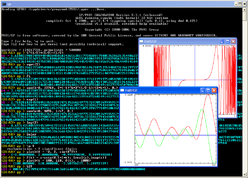This is an old revision of this page, as edited by 209.208.77.187 (talk) at 00:12, 6 December 2006 (Added a "See also" section.). The present address (URL) is a permanent link to this revision, which may differ significantly from the current revision.
Revision as of 00:12, 6 December 2006 by 209.208.77.187 (talk) (Added a "See also" section.)(diff) ← Previous revision | Latest revision (diff) | Newer revision → (diff) | |
 PARI/GP in use on Windows XP PARI/GP in use on Windows XP | |
| Developer(s) | Henri Cohen, Karim Belabas, et al., at the Université Bordeaux 1 |
|---|---|
| Stable release | 2.3.1 / October 5, 2006 |
| Repository | |
| Operating system | Cross-platform |
| Type | Computer algebra system |
| License | GNU General Public License |
| Website | PARI/GP Development Headquarter |
PARI/GP is a computer algebra system with the main aim of facilitating number theory computations. As of October 5 2006, the stable version is 2.3.1 and the development version is 2.4.0. It is free software since Version 2.1.0 and is distributed under the terms of the GNU General Public License as published by the Free Software Foundation. It runs on most common operating systems.
PARI/GP was originally developed in 1985 by a team led by Henri Cohen at Laboratoire A2X and is now maintained by Karim Belabas at the University of Bordeaux with the help of many volunteer contributors. PARI/GP's progenitor was a program named ISABELLE, an interpretor for higher arithmetic written in 1979 by Henri Cohen and François Dress (of the Université de Bordeaux I).
The PARI system is a package that is capable of doing formal computations on recursive types at high speed. It is primarily aimed at number theorists, but can be used by anybody whose primary need is speed. It can perform arbitrary precision calculations, including on irrational numbers (e.g., the significand can be millions of digits long—and billions of digits on 64-bit machines). It can be used to compute factorizations, to perform elliptic curve computations and to perform algebraic number theory. It also allows computations with matrices, polynomials, power series, algebraic numbers and implements many special functions.
PARI/GP also comes with its own built-in graphical plotting capability, and can be linked to gnuplot to use it for rendering plots.
Although quite an amount of symbolic manipulation is possible in PARI, the system does poorly compared to more sophisticated systems like Maxima, Axiom, Reduce, Macsyma, Mathematica or Maple on such manipulations as, e.g., multivariate polynomials, formal integration, and so on. On the other hand, the three main advantages of the system are its speed (which can be between 5 and 100 times better on many computations), the possibility of directly using data types that are familiar to mathematicians, and its extensive algebraic number theory module, which has no equivalent in the above-mentioned systems.
It is possible to use PARI in two different ways:
- As a library, which can be called from an upper-level language application (for instance, written in C, C++, Pascal, Fortran, Perl, or Python).
- As a sophisticated programmable calculator, named gp, which contains most of the control instructions of a standard language like C. It can be programmed in a language called GP.
A compiler called gp2c can be used to translate GP scripts to the C language.
Below are some samples of the calculator usage:
? \p 212 realprecision = 221 significant digits (212 digits displayed) ? 148.7^0.3721 time = 0 ms. %1 = 6.431568676168742823246396359599166309561461746185133095902233659267924 9836644243757491731497135665446717779810269870421893965849047805843823699959 892470992868949783084618518182456887849078305105083627437215091767
? 123456! + 0. time = 1,656 ms. %2 = 2.604069904929137872951393056092656881827327040950301958461018557995205 7379676834157935607166171279087355200170616660008572612714566985893730865282 934317244121152865814030204645985573419251305342231135573491050756 E574964
? sin(x) time = 0 ms. %3 = x - 1/6*x^3 + 1/120*x^5 - 1/5040*x^7 + 1/362880*x^9 - 1/39916800*x^11 + 1/6227020800*x^13 - 1/1307674368000*x^15 + O(x^17)
? for(z=25,30, print (factor(2^z-1))) time = 5 ms.
? e = ellinit(); ellidentify(e) time = 28 ms. %4 = , , , ]], ]
/* A famous rank 3 elliptic curve of conductor 5077. */
? K = bnfinit(x^2 + 23); K.cyc time = 1ms. %5 =
/* This number field has class number 3. */
See also
External links
- PARI/GP Development Headquarter
- Resources for PARI/GP at Karim Belabas's website
- Catalogue of GP/PARI Functions; also in downloadable gzipped tarball archive: Stable Branch
- "Le langage et l'interpréteur 'Isabelle', spécialement conçus pour utilisations arithmétiques," François Dress, Seminaire de Théorie des Nombres de Bordeaux, Vol. 9 (1979-1980); an article on ISABELLE, PARI/GP's ancestor progam created in 1979.